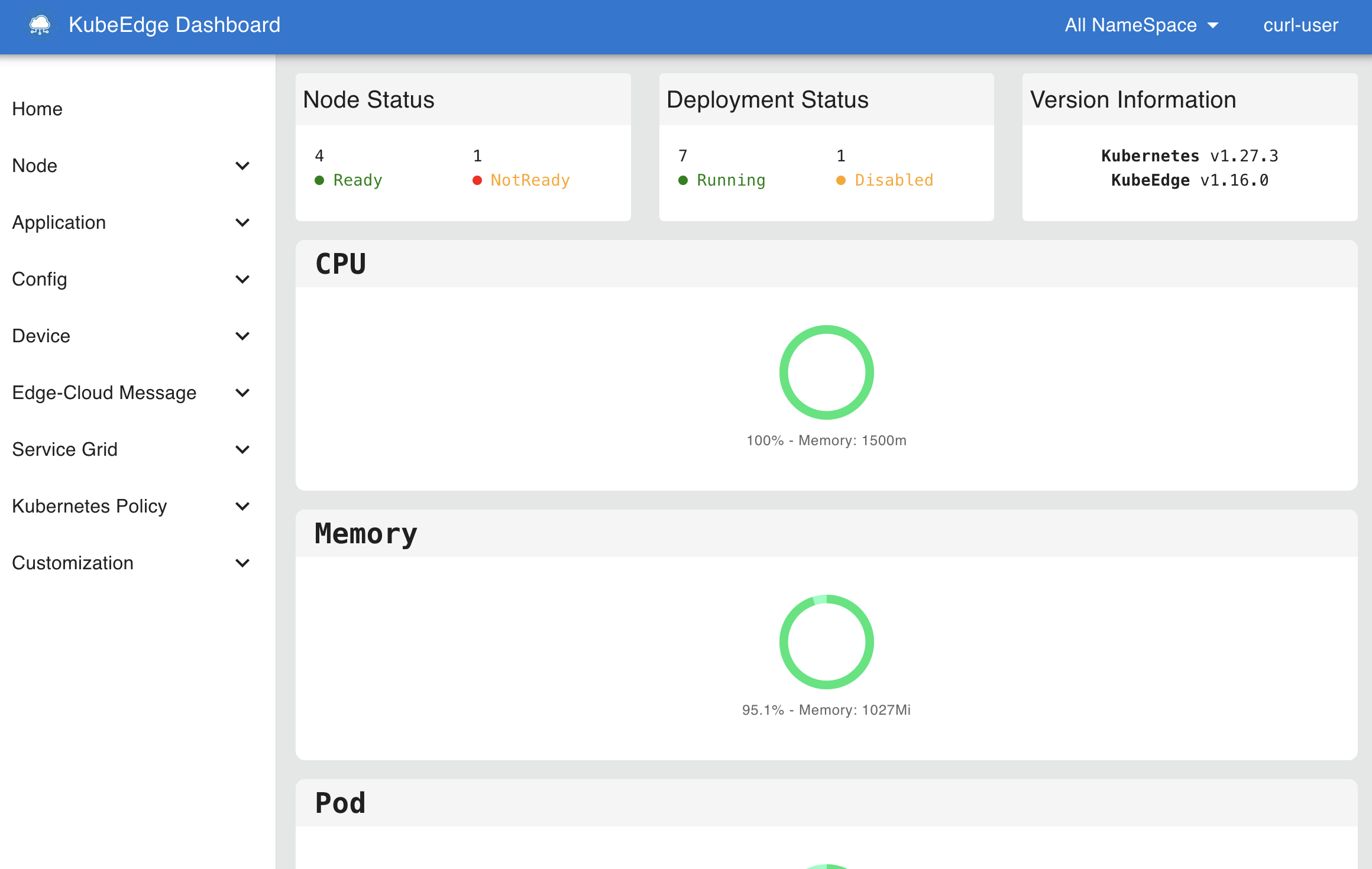北京时间2025年1月21日,KubeEdge发布1.20.0版本。新版本针对大规模、离线等边缘场景对边缘节点和应用的管理、运维等能力进行了增强,同时新增了多语言Mapper-Framework的支持。
KubeEdge v1.20 新增特性:
- 支持批量节点操作
- 多语言 Mapper-Framework 支持
- 边缘 keadm ctl 新增 pods logs/exec/describe 和 Devices get/edit/describe 能力
- 解耦边缘应用与节点组,支持使用Node LabelSelector
- 边云通道支持IPv6
- 升级k8s依赖到1.30
新特性概览
支持批量节点操作
在之前的版本中,keadm工具仅支持单个节点的安装与管理,然而在边缘场景中,节点数量通常比较庞大,单个节点的管理难以满足大规模场景的需求。
在1.20版本中,我们提供了批量节点操作和运维的能力。基于这个能力,用户仅需要使用一个配置文件,即可通过一个控制节点(控制节点可以登录所有边缘节点)对所有边缘节点进行批量操作和维护。keadm当前版本支持的批量能力包括join, reset和upgrade。
# 配置文件配置要求参考如下
keadm:
download:
enable: true # <Optional> Whether to download the keadm package, which can be left unconfigured, default is true. if it is false, the 'offlinePackageDir' will be used.
url: "" # <Optional> The download address of the keadm package, which can be left unconfigured. If this parameter is not configured, the official github repository will be used by default.
keadmVersion: "" # <Required> The version of keadm to be installed. for example: v1.19.0
archGroup: # <Required> This parameter can configure one or more of amd64/arm64/arm.
- amd64
offlinePackageDir: "" # <Optional> The path of the offline package. When download.enable is true, this parameter can be left unconfigured.
cmdTplArgs: # <Optional> This parameter is the execution command template, which can be optionally configured and used in conjunction with nodes[x].keadmCmd.
cmd: "" # This is an example parameter, which can be used in conjunction with nodes[x].keadmCmd.
token: "" # This is an example parameter, which can be used in conjunction with nodes[x].keadmCmd.
nodes:
- nodeName: edge-node # <Required> Unique name, used to identify the node
arch: amd64 # <Required> The architecture of the node, which can be configured as amd64/arm64/arm
keadmCmd: "" # <Required> The command to be executed on the node, can used in conjunction with keadm.cmdTplArgs. for example: "{{.cmd}} --edgenode-name=containerd-node1 --token={{.token}}"
copyFrom: "" # <Optional> The path of the file to be copied from the local machine to the node, which can be left unconfigured.
ssh:
ip: "" # <Required> The IP address of the node.
username: root # <Required> The username of the node, need administrator permissions.
port: 22 # <Optional> The port number of the node, the default is 22.
auth: # Log in to the node with a private key or password, only one of them can be configured.
type: password # <Required> The value can be configured as 'password' or 'privateKey'.
passwordAuth: # It can be configured as 'passwordAuth' or 'privateKeyAuth'.
password: "" # <Required> The key can be configured as 'password' or 'privateKeyPath'.
maxRunNum: 5 # <Optional> The maximum number of concurrent executions, which can be left unconfigured. The default is 5.`
# 配置文件参考用例 (各字段具体值请根据实际环境进行配置)
keadm:
download:
enable: true
url: https://github.com/kubeedge/kubeedge/releases/download/v1.20.0 # If this parameter is not configured, the official github repository will be used by default
keadmVersion: v1.20.0
archGroup: # This parameter can configure one or more of amd64\arm64\arm
- amd64
offlinePackageDir: /tmp/kubeedge/keadm/package/amd64 # When download.enable is true, this parameter can be left unconfigured
cmdTplArgs: # This parameter is the execution command template, which can be optionally configured and used in conjunction with nodes[x].keadmCmd
cmd: join --cgroupdriver=cgroupfs --cloudcore-ipport=192.168.1.102:10000 --hub-protocol=websocket --certport=10002 --image-repository=docker.m.daocloud.io/kubeedge --kubeedge-version=v1.20.0 --remote-runtime-endpoint=unix:///run/containerd/containerd.sock
token: xxx
nodes:
- nodeName: ubuntu1 # Unique name
arch: amd64
keadmCmd: '{{.cmd}} --edgenode-name=containerd-node1 --token={{.token}}' # Used in conjunction with keadm.cmdTplArgs
copyFrom: /root/test-keadm-batchjoin # The file directory that needs to be remotely accessed to the joining node
ssh:
ip: 192.168.1.103
username: root
auth:
type: privateKey # Log in to the node using a private key
privateKeyAuth:
privateKeyPath: /root/ssh/id_rsa
- nodeName: ubuntu2
arch: amd64
keadmCmd: join --edgenode-name=containerd-node2 --cgroupdriver=cgroupfs --cloudcore-ipport=192.168.1.102:10000 --hub-protocol=websocket --certport=10002 --image-repository=docker.m.daocloud.io/kubeedge --kubeedge-version=v1.20.0 --remote-runtime-endpoint=unix:///run/containerd/containerd.sock # Used alone
copyFrom: /root/test-keadm-batchjoin
ssh:
ip: 192.168.1.104
username: root
auth:
type: password
passwordAuth:
password: *****
maxRunNum: 5
# 用法 (保存以上文件,例如保存为 config.yaml)
# 在控制节点下载最新版本 keadm, 执行以下命令进行使用
keadm batch -c config.yaml
更多信息可参考:
https://github.com/kubeedge/kubeedge/pull/5988 https://github.com/kubeedge/kubeedge/pull/5968 https://github.com/kubeedge/website/pull/657
多语言Mapper-Framework支持
由于边缘IoT设备通信协议的多样性,用户可能需要使用Mapper-Framework生成自定义Mapper插件来纳管边缘设备。当前Mapper-Framework只能生成go语言版本的Mapper工程,对于部分不熟悉go语言的开发者来说使用门槛仍然较高。因此在新版本中,KubeEdge提供了Java版本的Mapper-Framework,用户可以访问 KubeEdge主仓库 的 feature-multilingual-mapper 分支,利用 Mapper-Framework 生成 Java 版的自定义 Mapper 工程。
更多信息可参考:
https://github.com/kubeedge/kubeedge/pull/5773 https://github.com/kubeedge/kubeedge/pull/5900
边缘keadm ctl新增 pods logs/exec/describe 和 Devices get/edit/describe 能力
在v1.17.0版本中,我们新增了keadm ctl子命令,支持在离线场景下对边缘pod进行查询和重启。在v1.20中我们对该命令做了进一步增强,支持pod的logs/exec/describe等功能,用户在边缘可对pod进行日志查询、pod资源详细信息查询、进入容器内部等操作。同时还新增了对device的操作,支持device的get/edit/describe的功能,可以在边缘获取device列表、device的详细信息查询、在边缘离线场景下对device进行编辑操作。
如下所示,新增的keadm ctl子命令功能均在MetaServer中开放了Restful接口,并与K8s ApiServer对应的接口完全兼容。
[root@edgenode1 ~]# keadm ctl -h
Commands operating on the data plane at edge
Usage:
keadm ctl [command]
Available Commands:
...
describe Show details of a specific resource
edit Edit a specific resource
exec Execute command in edge pod
get Get resources in edge node
logs Get pod logs in edge node
...
更多信息可参考:
https://github.com/kubeedge/kubeedge/pull/5752 https://github.com/kubeedge/kubeedge/pull/5901
解耦边缘应用与节点组,支持使用Node LabelSelector
EdgeApplication 可以通过节点组覆盖部署定义(如副本、镜像、命令和环境),Pod 流量在节点组内闭环(EdgeApplication 管理的 Deployment 共用一个 Service)。但在实际场景中,需要批量操作的节点范围与需要相互协作的节点范围并不相同。例如在智慧园区的场景中,每个城市都有很多个智慧园区,我们需要应用的流量在一个智慧园区内闭环,但应用批量管理的范围可能是城市级,也可能是省级。
我们在 EdgeApplication CRD 中为节点标签选择器添加了一个新的 targetNodeLabels 字段,该字段将允许应用程序根据节点标签进行部署,并且覆盖特定的字段,YAML定义如下:
apiVersion: apps.kubeedge.io/v1alpha1
kind: EdgeApplication
metadata:
name: edge-app
namespace: default
spec:
replicas: 3
image: my-app-image:latest
# New field: targetNodeLabels
targetNodeLabels:
- labelSelector:
- matchExpressions:
- key: "region"
operator: In
values:
- "HangZhou"
overriders:
containerImage:
name: new-image:latest
resources:
limits:
cpu: "500m"
memory: "128Mi"
更多信息可参考:
Issue: https://github.com/kubeedge/kubeedge/issues/5755
Pull Request: https://github.com/kubeedge/kubeedge/pull/5845
边云通道支持IPv6
我们在官网的文档中提供了一份配置指南,介绍了KubeEdge如何在Kubernetes集群中让云边 hub 隧道支持IPv6。文档地址:https://kubeedge.io/docs/advanced/support_ipv6
升级K8s依赖到v1.30
新版本将依赖的Kubernetes版本升级到v1.30.7,您可以在云和边缘使用新版本的特性。
更多信息可参考:
https://github.com/kubeedge/kubeedge/pull/5997
版本升级注意事项
- 从v1.20.0版本开始,EdgeCore的配置项edged.rootDirectory的默认值将会由
/var/lib/edged切换至/var/lib/kubelet,如果您需要继续使用原有路径,可以在使用keadm安装EdgeCore时设置--set edged.rootDirectory=/var/lib/edged。
